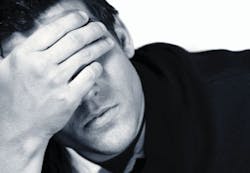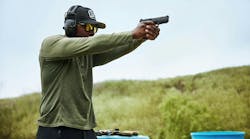On any shift, police officers may be expected to shoot someone, be shot at, see a partner killed, use force to resist a physical attack, rescue a battered child, participate in a high-speed chase, and inform a parent that his or her child has been killed in a traffic accident. It's a small wonder that police officers are twice as likely to die by their own hand than by that of an assailant.
Suicide is not the only adverse outcome to result from police work. The pressures of law enforcement also put officers' physical and mental health at risk. The University of Buffalo (UB) conducted a long-term study that followed more than 400 police officers. Results showed that officers over the age of 40 have a higher 10-year risk of a coronary event than the national average. It went on to illustrate 72 percent of female officers and 43 percent of male officers have higher than recommended cholesterol levels, and police as a group have higher than average pulse rates and diastolic blood pressure.
"Policing is psychologically stressful work, filled with danger, high demands, human misery and exposure to death," says John Violanti, a professor in the UB department of social and preventative medicine. Violanti is himself a 23-year veteran of the New York State Police.
Violanti hopes his work, called the Buffalo Cardio-Metabolic Occupational Police Stress (or BCOPS) study, may lead to police department-centered interventions to reduce the risk of stress-related disease among police. Violanti used measures of cortisol, also called the "stress hormone," to determine how stress is associated with physiological risk factors that can lead to serious health problems such as diabetes and cardiovascular disease.
Other studies have shown that when cortisol becomes dysregulated due to chronic stress, a person is more likely to become ill. The body becomes physiologically unbalanced, organs are attacked, and the immune system is compromised. "That's what stress does to us," notes Violanti.
BCOPS' two most recent segments report on the effect of shift work on stress and suicide risk in police, and on male/female differences in stress and signs of cardiovascular disease.
High plains shifterResults of the shift work study, involving 115 randomly selected officers, showed that suicidal thoughts were higher in women working the day shift, and in men working swing and graveyard shifts. Data showed that nearly twice as many male officers (23 percent) and female officers (25 percent) reported suicidal thoughts than the general population (13 percent).
Violanti says the results that women working day shifts were more likely to experience depression and suicide ideation, while the finding in men working the afternoon and night shift were related to PTSD and depression, were surprising. The assumption was that both men and women officers would be negatively affected by midnight shifts.
"It's possible women may feel more uneasy and stressed in a daytime shift, where there can be more opportunity for conflict and a negative environment," he says.
On the other hand, higher suicide ideation reported by males on the midnight shift may be accounted for in part by a stronger need to be part of the social cohesiveness associated with peers in the department.
"Working alone at night without support of immediate backup can be stressful," notes Violanti. There is also the issue of physiological disruption of circadian rhythms. Being awake at night when one should be sleeping can affect judgment and decision-making. The Chernobyl, Three Mile Island, Bhopal, Exxon Valdez and Space Shuttle Challenger disasters all occurred during the night shift.
Change of heartThe stress and blood vessel reactivity research also found that females had higher cortisol levels upon awakening, and that levels remained high throughout the day. Normally, cortisol is highest in the morning and decreases to its lowest in the evening.
"These constantly high cortisol levels were associated with less arterial elasticity, a risk factor for cardiovascular disease," Violanti says. An earlier section of the BCOPS study looked at how the incidence of subclinical atherosclerosis, or the arterial thickening that precedes heart attack and stroke, relates to police stress. The study took factors associated with atherosclerosis such as diet, exercise and smoking into account in a comparison of 322 police officers and 318 healthy citizens.
Investigators used ultrasound to examine subjects for thickness of the carotid artery to use as an indicator of increasing risk of atherosclerosis. Investigators also measured blood pressure, body size, cholesterol and glucose. All measurements were taken in the morning after a 12-hour fast. Results showed, all else being equal, police work was associated with increased subclinical cardiovascular disease.
"Arterial plaque buildup among police was greater than the civilian population," adds Violanti.
In future work, Violanti intends to re-measure carotid artery thickness to see how much it has increased. At some stage, medical intervention and treatment will be indicated.
"Police officers will likely reach that state quicker than the general population," Violanti says.
Managing stressIn conducting similar studies, most police work research fails to address a fundamental concern — that of gender. In the first work to examine the gendering of stress and burnout in modern policing, researchers found that stress and burnout by officers is embedded in the gender structure and process of policing, and not simply a response to high stress.
In this study, Kansas State Sociologist Don Kurtz looked at how male and female police officers manage stress. The primary purpose was to explore how gender interacts with stress management and their individual psychological health. Kurtz examined data from a survey of police officers in the Baltimore Police Department, and interviewed officers from three other departments.
"This study is important because stress and burnout remain significant problems in law enforcement agencies, including negative attempts to manage stress with excessive alcohol consumption," Kurtz says.
He found the different ways in which male and female officers deal with stress may actually cause them more, as the two genders have different sources of stress and different ways of dealing with it. Telling war stories is almost exclusively a male endeavor, for instance.
"In social settings, male officers often talk about stressful events, but remove the fear and emotion that accompany these events and replace it with superhuman qualities," he says. On the other hand, women officers often feel excluded from war stories, and may feel that if they exaggerate stories the way males do they could be questioned. "So, it becomes a male-only way of managing stress," adds Kurtz.
He suggests that in some ways women officers have a better chance of dealing with violent cases because it's more acceptable for females to be upset or vulnerable.
"For male officers to show emotion is career suicide," he says.
Race, stress & burnoutKurtz also found indications that gender and race intersect in interesting ways. For instance, women, both white and African American, reported higher levels of stress than white men, but African-American men indicated lower levels of stress than white men.
"Although it is not surprising that women experience more stress than men given the gendered nature of police organizations and the reports of hostile work environments in many departments, it is not clear why African-American men reported lower levels of stress than white men," Kurtz says.
These findings are even more intriguing when combined with the effects of race and gender on burnout. Kurtz reports there were no apparent effects of race and gender on burnout — with one exception: African-American men, though experiencing lower rates of stress, exhibit higher levels of burnout than white men. He notes that additional research is indicated to explore these findings in more detail.
He speculates that "perhaps African-American men have better coping strategies than white men and women, but stress still takes its toll over time, resulting in burnout when it finally manifests itself."
Home sweet homeKurtz also found that family support tended to mitigate the effects of stress and burnout to a greater degree than administrative support. Family support was significantly associated with reduced burnout for both men and women, which is perhaps intuitive.
The bureaucratic nature of law enforcement agencies may limit the ability of single administrators to reduce stress among field officers. Kurtz says officers frequently believe that their patrol decisions lack support by departmental administration, which is compounded by the fact that many officers believe the public does not support their efforts.
"Perhaps the bureaucratic nature of the workplace makes it hard for administrators to mediate stress, regardless of gender," he suggests. On the other hand, administrative support may relate to burnout and help retain female officers in a hostile environment, thereby reducing burnout. Kurtz says nationally, police agencies have had limited support in increasing the number of women in the field, and even when departments are able to recruit women, they often have difficulty retaining them. Studies have shown that female police officers are more apt than males to report that the command structure treats them differently based on gender.
"Although the current study cannot document the extent, it is logical to assume that when agencies refuse to tolerate sexist behavior in the workplace, women perceive this behavior as support from their administration, thereby reducing burnout for women," Kurtz says.
He adds that perhaps the most interesting contribution of his findings is the importance of gender dynamics in law enforcement work environments, underscoring the need for including gender influences in the analysis of police stress and burnout.
"It is not surprising that male officers were most apt to believe that women were treated more leniently," Kurtz notes. The perception that women are physically too weak to fulfill the sometimes physical demands of law enforcement is a recurring theme. Prior research shows that, for the most part, male officers viewed female officers as a liability, believing they lack the physical size to contain violent offenders and create safety concerns in patrol situations.
"It is perhaps also not surprising that male officers who endorse this view are more likely to experience stress and burnout if they think they are being treated unfairly or that women are somehow getting by without living up to departmental expectations," Kurtz adds.
There is a solutionResearchers admit that publishing papers and conducting stress studies will not influence police departments to change overnight, but it is one way to get the word out so the negative effects of stress must be acknowledged, de-stigmatized and treated.
"Intervention is necessary to help officers deal with this difficult occupation," Violanti advises. "We want to educate on how to survive 25 years of law enforcement."
Violanti says police need to learn how to relax and think differently about things they experience on the street. Remedies are particularly difficult given the strength of the police subculture. Law enforcement remains a profession dominated by men, and many of the stress management practices still relate to gendered expectations of behavior, particularly the idea of how men handle stressful situations.
"Many officers fear being labeled weak or unreliable if they show any emotional response to stress," Kurtz notes. "This was clearly evident for men who are expected to behave in a masculine manner [and] sets up unrealistic expectations for officers."
Kurtz says finding ways for officers to openly discuss stress without stigma may resolve some of these negative outcomes. However, these sessions should not be seen as psychological counseling because they would then involve significant stigma. "Group interaction other than binge drinking sessions or other traditional after-work activities might be productive," he suggests.
And there is such a thing as post-traumatic growth.
Violanti says:"People can grow in a positive way and be better cops — and people — after they survive the trauma of police work."
Douglas Page writes about science, technology and medicine from Pine Mountain, Calif. He can be reached at [email protected]



